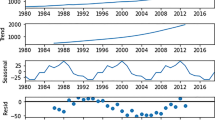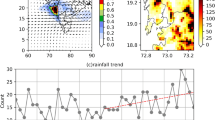Abstract
Several hourly, daily and monthly global solar radiation prediction models have been designed, to overcome the weakness of the previous models. Many previous models have used a long-term global solar radiation of Seoul to predict the consecutive years. Unfortunately, many countries do not have an enough history to build such prediction models, in addition many researchers suggested that seasonal autoregressive integrated moving average (SARIMA) is better than nonlinear autoregressive exogenous (NARX) neural network in predicting global solar radiation. Therefore, this research comes to fill the gaps in previous work, develop prediction model based on short-term global solar radiation, and test the best model between NARX and SARIMA by using global solar radiation of Seoul. The methodology divided the developed models into two parts including train phase and test phase. Train phase used dataset between 2007 and 2013, where test phase used dataset between 2014 and 2015. Afterward, the developed models are validated and tested using determination coefficient (R2) and different error function and the results are compared to two previous model that used long-term dataset namely ANFIS model and SARIMA. The results showed that the determination coefficient (R2) and RMSE of NARX model based on hourly data are 0.95 and 0.23 MJ/m2, respectively, besides the best daily and monthly average solar radiation predictors are obtained when NARX and hourly data are used. The results revealed that using hour, day, month and year as independent variables and less history with NARX model is efficient to predict two consecutive years.





















Similar content being viewed by others
Data Availability
All the used datasets are collected by Korea Meteorological Administration (KMA).
References
Nadia, A.R.; Isa, N.A.M.; Desa, M.K.M.: Advances in solar photovoltaic tracking systems: a review. Renew. Sustain. Energy Rev. 82, 2548–2569 (2018)
AL-Rousan, N.A.; Isa, N.A.M.; Desa, M.K.M.: Efficient single and dual axis solar tracking system controllers based on adaptive neural fuzzy inference system. J. King Saud. Univ. 32(7), 459–469 (2020)
Al-Rousan, N.; Al-Najjar, H.; Alomari, O.: Assessment of predicting hourly global solar radiation in Jordan based on rules, trees, meta, lazy and function prediction methods. Sustain. Energy Technol. Assess. 44, 100923 (2021)
Achour, L.; Bouharkat, M.; Assas, O.; Behar, O.: Hybrid model for estimating monthly global solar radiation for the Southern of Algeria: (case study: Tamanrasset, Algeria). Energy 135, 526–539 (2017)
Ismail, M.T.; Shah, N.Z.A.; Karim, S.A.A.: Modeling solar radiation in peninsular Malaysia using ARIMA model. In: Sulaiman, S.A. (Ed.) Clean Energy Opportunities in Tropical Countries, pp. 53–71. Springer, Singapore (2021)
Sharadga, H.; Hajimirza, S.; Balog, R.S.: Time series forecasting of solar power generation for large-scale photovoltaic plants. Renew. Energy 150, 797–807 (2020)
Boussaada, Z.; Curea, O.; Remaci, A.; Camblong, H.; Mrabet Bellaaj, N.: A nonlinear autoregressive exogenous (NARX) neural network model for the prediction of the daily direct solar radiation. Energies 11(3), 620 (2018)
Alsharif, M.H.; Younes, M.K.; Kim, J.: Time series ARIMA model for prediction of daily and monthly average global solar radiation: the case study of Seoul, South Korea. Symmetry 11(2), 240 (2019)
Bounoua, Z.; Chahidi, L.O.; Mechaqrane, A.: Estimation of daily global solar radiation using empirical and machine-learning methods: a case study of five Moroccan locations. S&mT Sustain. Mater. Technol. 28, e00261 (2021)
Benmouiza, K.; Cheknane, A.: Forecasting hourly global solar radiation using hybrid k-means and nonlinear autoregressive neural network models. Energy Convers. Manag. 75, 561–569 (2013)
Lotfinejad, M.; Hafezi, R.; Khanali, M.; Hosseini, S.; Mehrpooya, M.; Shamshirband, S.: A comparative assessment of predicting daily solar radiation using bat neural network (BNN), generalized regression neural network (GRNN), and neuro-fuzzy (NF) system: a case study. Energies 11(5), 1188 (2018)
Ojo, O.S.; Adeyemi, B.: Application of nonlinear autoregressive neural network to estimation of global solar radiation over Nigeria. Adv. Mater. Sci. Eng. 3(2), 68–79 (2020)
Chen, S.X.; Gooi, H.B.; Wang, M.Q.: Solar radiation forecast based on fuzzy logic and neural networks. Renew. Energy 60, 195–201 (2013)
Elminir, H.K.; Areed, F.F.; Elsayed, T.S.: Estimation of solar radiation components incident on Helwan site using neural networks. Sol. Energy 79(3), 270–279 (2005)
Lima, M.A.F.B.; Carvalho, P.C.; Braga, A.P.D.S.; Ramírez, L.M.F.; Leite, J.R.: MLP back propagation artificial neural network for solar resource forecasting in equatorial areas. Renew. Energy Power Qual. J. 1, 175–180 (2018)
Khatib, T.; Mohamed, A.; Sopian, K.; Mahmoud, M.: Assessment of artificial neural networks for hourly solar radiation prediction. Int. J. Photoenergy 2012, 1–7 (2012)
Mohammad, A.T.; Mahmood, I.; Mahjoob, S.: Three structures of a multilayer artificial neural network for predicting the solar radiation of Baghdad City-Iraq. Int. J. Appl. Eng. Res. 13(6), 3759–3766 (2018)
Priya, S.S.; Iqbal, M.H.: Solar radiation prediction using artificial neural network. Int. J. Comput. Appl. 116(16), 28–31 (2015)
Benghanem, M.; Mellit, A.; Alamri, S.N.: ANN-based modelling and estimation of daily global solar radiation data: a case study. Energy Convers. Manag. 50(7), 1644–1655 (2009)
Belmahdi, B.; Louzazni, M.; El Bouardi, A.: One month-ahead forecasting of mean daily global solar radiation using time series models. Optik 219, 165207 (2020)
Moghaddamnia, A.; Remesan, R.; Kashani, M.H.; Mohammadi, M.; Han, D.; Piri, J.: Comparison of LLR, MLP, Elman, NNARX and ANFIS models—with a case study in solar radiation estimation. J. Atmos. Sol. Terr. Phys. 71(8–9), 975–982 (2009)
Durrani, S.P.; Balluff, S.; Wurzer, L.; Krauter, S.: Photovoltaic yield prediction using an irradiance forecast model based on multiple neural networks. J. Mod. Power Syst. Clean Energy 6(2), 255–267 (2018)
Kisi, O.; Heddam, S.; Yaseen, Z.M.: The implementation of univariable scheme-based air temperature for solar radiation prediction: new development of dynamic evolving neural-fuzzy inference system model. Appl. Energy 241, 184–195 (2019)
Ghimire, S.; Deo, R.C.; Raj, N.; Mi, J.: Deep solar radiation forecasting with convolutional neural network and long short-term memory network algorithms. Appl. Energy 253, 113541 (2019)
Ghimire, S.; Deo, R.C.; Raj, N.; Mi, J.: Wavelet-based 3-phase hybrid SVR model trained with satellite-derived predictors, particle swarm optimization and maximum overlap discrete wavelet transform for solar radiation prediction. Renew. Sustain. Energy Rev. 113, 109247 (2019)
Yadav, A.K.; Chandel, S.S.: Solar radiation prediction using artificial neural network techniques: a review. Renew. Sustain. Energy Rev. 33, 772–781 (2014)
Meenal, R.; Selvakumar, A.I.: Assessment of SVM, empirical and ANN based solar radiation prediction models with most influencing input parameters. Renew. Energy 121, 324–343 (2018)
Zou, L.; Wang, L.; Xia, L.; Lin, A.; Hu, B.; Zhu, H.: Prediction and comparison of solar radiation using improved empirical models and adaptive neuro-fuzzy inference systems. Renew. Energy 106, 343–353 (2017)
Li, D.H.; Chen, W.; Li, S.; Lou, S.: Estimation of hourly global solar radiation using Multivariate Adaptive Regression Spline (MARS)—a case study of Hong Kong. Energy 186, 115857 (2019)
Qing, X.; Niu, Y.: Hourly day-ahead solar irradiance prediction using weather forecasts by LSTM. Energy 148, 461–468 (2018)
Jiang, H.; Lu, N.; Qin, J.; Tang, W.; Yao, L.: A deep learning algorithm to estimate hourly global solar radiation from geostationary satellite data. Renew. Sustain. Energy Rev. 114, 109327 (2019)
Hocaoglu, F.O.; Serttas, F.: A novel hybrid (Mycielski–Markov) model for hourly solar radiation forecasting. Renew. Energy 108, 635–643 (2017)
Fan, J.; Wu, L.; Ma, X.; Zhou, H.; Zhang, F.: Hybrid support vector machines with heuristic algorithms for prediction of daily diffuse solar radiation in air-polluted regions. Renew. Energy 145, 2034–2045 (2020)
Halabi, L.M.; Mekhilef, S.; Hossain, M.: Performance evaluation of hybrid adaptive neuro-fuzzy inference system models for predicting monthly global solar radiation. Appl. Energy 213, 247–261 (2018)
Al-Najjar, H.; Al-Rousan, N.; Al-Najjar, D.; Assous, H.F.; Al-Najjar, D.: Impact of COVID-19 pandemic virus on G8 countries’ financial indices based on artificial neural network. J. Chin. Econ. Foreign Trade Stud. 14, 89–103 (2021)
Alshinwan, M.; Abualigah, L.; Shehab, M.; Abd Elaziz, M.; Khasawneh, A.M.; Alabool, H.; Al Hamad, H.: Dragonfly algorithm: a comprehensive survey of its results, variants, and applications. Multimed. Tools. Appl. 80, 14979–15016 (2021)
Abualigah, L.: Group search optimizer: a nature-inspired meta-heuristic optimization algorithm with its results, variants, and applications. Neural Comput. Appl. Neural Comput. Appl. 33, 2949–2972 (2020)
Al-Rousan, N.; Al-Najjar, H.: Optimizing the performance of MLP and SVR predictors based on logical oring and experimental ranking equation. J. Chin. Inst. Eng. 44(2), 149–157 (2021)
Assous, H.F.; Al-Rousan, N.; Al-Najjar, D.; Al-Najjar, H.: Can international market indices estimate TASI’s movements? The ARIMA model. J. Open Innov. Technol. Market Complex. 6(2), 27 (2020)
Lfakir, A.; Thevenin, P.: Prediction of time series of photovoltaic energy production using artificial neural networks. In: Advanced Intelligent Systems for Sustainable Development (AI2SD'2018). Advanced Intelligent Systems Applied to Energy, vol. 2, p. 246 (2019)
Taki, M.; Rohani, A.; Yildizhan, H.: Application of machine learning for solar radiation modeling. Theor. Appl. Climatol. 143(3), 1599–1613 (2021)
Huang, J.H.; Liu, H.: A hybrid decomposition-boosting model for short-term multi-step solar radiation forecasting with NARX neural network. J. Cent. South Univ. 28(2), 507–526 (2021)
Ozoegwu, C.G.: Artificial neural network forecast of monthly mean daily global solar radiation of selected locations based on time series and month number. J. Clean. Prod. 216, 1–13 (2019)
Chan, H.K.; Xu, S.; Qi, X.: A comparison of time series methods for forecasting container throughput. Int. J. Logist. Res. Appl. 22(3), 294–303 (2019)
Beard, E.; Marsden, J.; Brown, J.; Tombor, I.; Stapleton, J.; Michie, S.; West, R.: Understanding and using time series analyses in addiction research. Addiction 114, 1866–1884 (2019)
Korea Meteorological Administration (KMA): Synoptic Weather Observation. Available online: https://data.kma.go.kr/data/grnd/selectAsosList.do?pgmNo=34. Accessed 22 Jan 2019
Inanlougani, A.; Reddy, T.A.; Katiamula, S.: Evaluation of Time-Series, Regression and Neural Network Models for Solar Forecasting: Part I: One-Hour Horizon. arXiv preprint arXiv:1708.08376 (2017)
Buitrago, J.; Asfour, S.: Short-term forecasting of electric loads using nonlinear autoregressive artificial neural networks with exogenous vector inputs. Energies 10(1), 40 (2017)
Wunsch, A.; Liesch, T.; Broda, S.: Forecasting groundwater levels using nonlinear autoregressive networks with exogenous input (NARX). J. Hydrol. 567, 743–758 (2018)
Mandic, D.P.; Chambers, J.: Recurrent Neural Networks for Prediction: Learning Algorithms, Architectures and Stability. Wiley, New York (2001)
Alsharif, M.H.; Younes, M.K.: Evaluation and forecasting of solar radiation using time series adaptive neuro-fuzzy inference system: Seoul city as a case study. IET Renew. Power Gener. 13(10), 1711–1723 (2019)
Nadia, A.R.; Al-Rousan, M.; Shareiah, A.: A fuzzy logic model of a tracking system for solar panels in northern Jordan based on experimental data. In: 2012 International Conference on Renewable Energy Research and Applications (ICRERA), pp. 1–6 (2012)
Nadia, A.R.; Al-Rousan, M.; Shareiah, A.; Hazem, A.N.: Choosing the efficient tracking method for real time tracking system in Jordan and it's neighbors to get maximum gained power based on experimental data. In: 2012 International Conference on Renewable Energy Research and Applications (ICRERA), pp. 1–6 (2012)
Al-Rousan, N.A.; Isa, N.A.M.; Desa, M.K.M.: Correlation analysis and MLP/CMLP for optimum variables to predict orientation and tilt angles in intelligent solar tracking systems. Int. J. Energy Res. 45(1), 453–477 (2020)
Author information
Authors and Affiliations
Contributions
These authors are contributed equally to this work.
Corresponding author
Ethics declarations
Conflict of interest
The authors declare they have no competing interests.
Rights and permissions
About this article
Cite this article
AL-Rousan, N., Al-Najjar, H. A Comparative Assessment of Time Series Forecasting Using NARX and SARIMA to Predict Hourly, Daily, and Monthly Global Solar Radiation Based on Short-Term Dataset. Arab J Sci Eng 46, 8827–8848 (2021). https://doi.org/10.1007/s13369-021-05669-6
Received:
Accepted:
Published:
Issue Date:
DOI: https://doi.org/10.1007/s13369-021-05669-6




